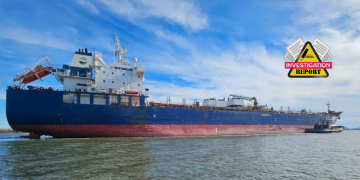MAN has issued a Market Update Note providing information on the Light Running Margin (LRM) which is an important design parameter for the safe and efficient operation of a ship. The changed circumstances in the shipping industry have led MAN Diesel & Turbo to change the recommendation for LRM.
- a safe and satisfactory ship speed can be maintained in heavy weather and/or with a fouled hull
- ship accelerations needed for safe and efficient manoeuvring operations can be achieved
- a barred speed range can be passed quickly (which is often required also at zero ship speed, i.e. at bollard pull).
Light Running Margin (LRM)
To align with the rest of world’s ambitions to reduce greenhouse gas emissions, the shipping industry has developed the energy efficiency design index (EEDI) in cooperation with IMO. Combined with the steady increase in oil prices seen in the period from 2006 to 2014, the result has been improved ship designs with lower CO2 emissions relative to their transportation capacity.
Lowering of the SMCR propulsion power installed is a key parameter for achieving a more fuel and CO2-efficient ship, evaluated according to the EEDI. Other parameters include lowering of the hull resistance, improving the hydrodynamic propulsion efficiency, and lowering of the specific fuel consumption of the main engine.
For a specific ship, less power installed will not only reduce the top speed of the vessel, but also reduce the vessel’s capability of accelerating or sailing with increased resistance from heavy sea and/or fouling of the hull
To illustrate the situation, you could think of a car that has been fitted with an engine with less power than usual. The car would definitely have a lower top speed and acceleration, and the uphill running capability would be poorer. In those situations the lower power would have to be compensated for by using a lower gear ratio. However, a ship with an engine coupled directly to a fixed pitch propeller cannot shift gear. So, to cope with a smaller main engine, the engine and propeller must be designed with a lower gear ratio from the beginning, for example by using a propeller with a reduced pitch.
For a certain power, a reduction of the pitch will result in a higher engine speed. The ratio between the rpm value on the light propeller curve and the rpm value on the nominal propeller curve through SMCR is called the light running margin (LRM)

The LRM can be thought of as the ship’s gearing. The effect of changing the LRM, and thereby the ships gearing, is indicated in the table below.
| Larger LRM | Smaller LRM | |
| Ship gearing | Lower | Higher |
| Engine acceleration | Faster | Slower |
| Ship acceleration | Faster | Slower |
| Heavy weather ship speed | Higher | Lower |
| Propeller speed | Higher | Lower |
A larger LRM will reduce the daily fuel oil consumption in heavy weather because engine efficiency will be higher. Some ships may see a marginal increase in the daily fuel oil consumption in calm weather with an increased LRM. However, such a marginal increase in calm weather will be counteracted by a reduced consumption in heavy weather. In general, the average daily fuel consumption is largely unaffected by a larger LRM. Since 1999, our recommendation has been an LRM of 3-7%. But in view of the above development, and the service feedback received from newly delivered low-powered ships reporting poor acceleration and low heavy weather ship speed, it is increasingly important that ship designers and yards carefully consider how much LRM is required for a particular ship. The LRM should be sufficiently large to ensure a safe and satisfactory ship speed during heavy weather and satisfactory acceleration during manoeuvring.
The MAN B&W engine load diagram limits have stayed unchanged for years, and the basic designs of engine components with regards to stresses, temperatures, emissions etc., have been made up to these limits, leaving no room for a general increase of these limits.
In the coming years, the EEDI will put even stronger demands on a ship’s fuel efficiency and CO2 emission, and we may see yards installing engines with even less power than today. So, to facilitate such ship designs from the yards, we will, for new projects as of 1st of May 2015, change our LRM recommendation to 4-10% that is applicable to all draughts at which the ship is intended to operate, whether ballast, design or scantling draught.
Reducing SMCR power while maintaining available power for critical condition
In order to explain the influence of the LRM selected, this example demonstrates how two ships, A and B, with the same hull and propeller, but with 10% less SMCR power for ship B, require a different LRM to ensure that the same power is available to the propeller in heavy running conditions.


The conclusion from example 1 is that if the LRM is increased sufficiently, it is possible to reduce the engine SMCR power while still maintaining the available engine power output in critical conditions, such as very heavy weather and during manoeuvring at low ship speeds. Fig. above an example with a 10% reduction of the main engine power.
The relation between the SMCR power reduction and the required increase in LRM for unchanged heavy propeller performance is nearly linear. For example, if the SMCR power was reduced by 20%, the corresponding LRM for unchanged power with heavy propeller would be about 9%.
Example 2
Increasing the LRM to improve ship manoeuvring performance
To explain how increasing the LRM can dramatically improve the available engine power for manoeuvering, this example demonstrates the difference in available engine power for two different choices of LRM.
To ensure s
ufficient steering forces on the rudder and sufficient ahead and astern accelerations of the vessel during ship manoeuvring in port or in otherwise restricted waters, it is important that the ship can quickly reach the necessary propeller speed even when the ship speed is zero (bollard pull). Pilots may complain about poor acceleration performance if it is not possible to reach half ahead revolutions quickly in such conditions. It is therefore relevant to consider the bollard pull propeller curve in relation to the engine load diagram.
It is MAN’s experience that in the bollard pull condition the propeller is operating on a propeller curve that is 15% to 20% heavy running relative to the light propeller curve. Fig. 4 shows two different bollard pull propeller curves in the same engine load diagram. The two propellers have been designed with different LRMs. One propeller has 3% LRM and the other 10% LRM, representing the combined range of our previous and new LRM recommendation. The light propeller curves are not shown in Fig. 4, instead bollard pull curves with 17.5% heavy running relative to the light propeller curves are shown (average of 15% to 20%).

for propellers with different LRMs. The heavy propeller has 3% LRM, the light
propeller has 10% LRM. The power margin shown represents the power excess
for acceleration of engine and propeller inertia
In the bollard pull condition, if the engine has been given a “half ahead” speed setting, the power available to accelerate the propeller is limited by the load diagram (the torque limit). The power available to accelerate the propeller cannot be higher than the gap between the load diagram and the bollard pull propeller. See the power margin illustrated in above figure. This power margin accelerates the inertia of the engine and the propeller until the propeller curve crosses the engine load diagram where the power margin becomes zero. From this point in time, the propeller will only accelerate gradually as the ship accelerates, and the speed of the water flow towards the propeller therefore increases making the propeller curve lighter.
The figure shows that choosing 10% LRM instead of 3% increases the available bollard pull power from 41% of SMCR power to 61% (assuming 17.5% heavy running relative to the light propeller curve due to the bollard pull condition). This is a large difference. The increase in bollard pull power is ~50%. The corresponding difference in engine rpm is from 63% to 77%. Considering that a typical “half ahead” speed setting is somewhere between 60% and 70% rpm the choice of LRM can decide whether it is possible to reach “half ahead” in bollard pull or not. It is therefore important to include manoeuvring in the considerations when selecting the LRM for a ship.
The conclusion from example 2 is that the choice of LRM has a strong impact on ship maneuverability. Increasing the LRM increases the manoeuvrability, reducing the LRM reduces manoeuvrability.
Quick passage of a barred speed range
Due to excessive torsional vibrations at certain shaft speeds, many shaft lines have a barred speed range. Above figure includes an example of such a barred speed range. In order not to damage the shaft line, it must be possible to pass this barred speed range quickly in all relevant conditions. As a general rule, the barred speed range should be passed in seconds, not minutes. But the required maximum passage time depends on the magnitude of the stress levels in relation to the shaft material used and the operational profile of the ship (how often is it required to pass the barred speed range).
If the power margin between the actual propeller curve and the engine load diagram is too small within the barred speed range, passage of the barred speed range can take unacceptably long time. Increasing the LRM will increase the power margin in the barred speed range and thus reduce the time required for passage of the barred speed range, see Figure.
A ship should have sufficient LRM such that:
• Safe and satisfactory ship speed can be maintained in heavy weather and/or with a fouled hull.
• Ship accelerations needed for safe and efficient manoeuvring operations can be achieved.
• A barred speed range can be passed quickly. This is often required also at zero ship speed (bollard pull).
Please click below to dowload MAN’s Market Update Note on Light Running Margin
In the origin, I was straightforward with you propecia before and after has changed my existence. It has become much more fun, and now I have to run. Just as it is improbable to sit.





























































